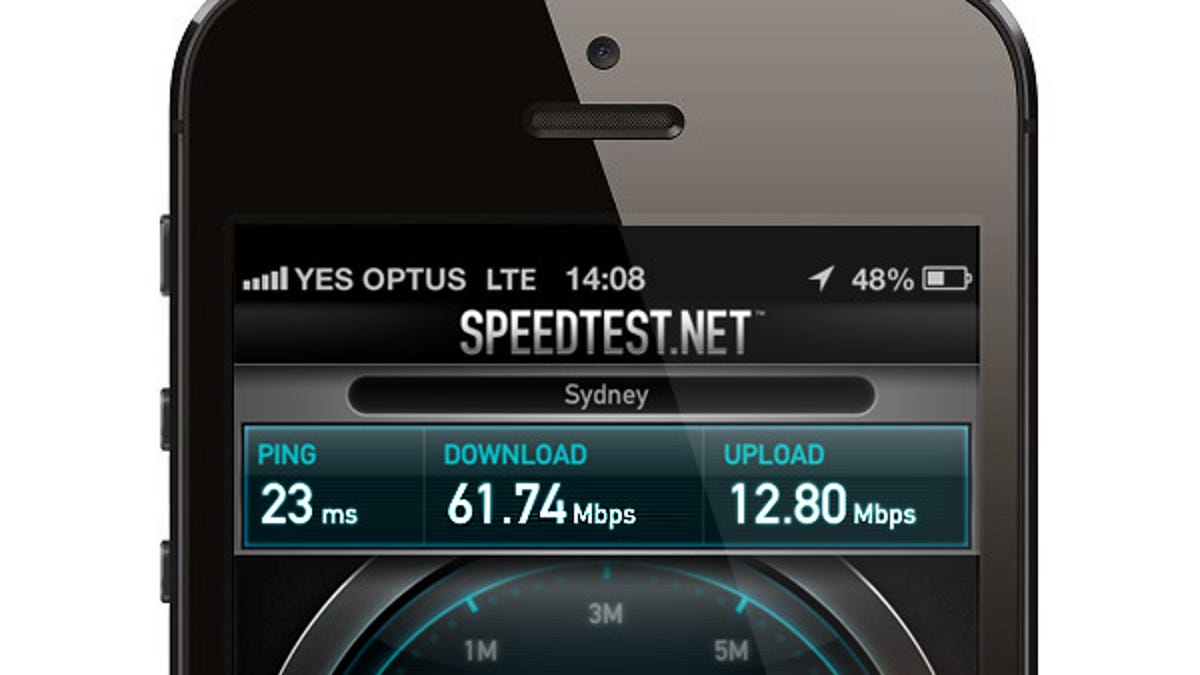These LTE speeds will make you cry
Excited about the LTE speeds you're getting with your new Verizon or AT&T smartphone? Well, they're nothing compared with what we get in Australia.

If you want fast 4G, move to Australia.
After looking over recent LTE test results from San Francisco and New York where downloads speeds topped out at 23.6Mbps, I feel an uncontrollable urge to gloat. Our 4G speeds in Australia are up to four times faster, and here's why.
Signal strengths (and weaknesses)
First, there are technological differences between the 4G networks in Australia and similar networks in the United States. Significantly, they operate on higher frequencies, with both Tesltra and Optus (two of our biggest carriers) repurposing (mostly) unused 1,800MHz spectrum to deliver 4G services, while Verizon and AT&T have bought 700MHz spectrum after analog TV gave way to digital TV broadcasting.
The lower 700MHz frequency signals travel farther and are better for covering large areas of land, which is essential for a country the size of the United States. The 1,800MHz frequency is better at dealing with larger loads, though, so more users can be using the network at once before the strain affects speeds too much. Using 1,800Mhz does put the onus on the Australian carriers to build out more infrastructure, but so long as these companies cover the population adequately, the speeds should remain solid. So here the speeds I encountered recently when using Ookla's SpeedTest.net app on a
Sydney Central Business District (CBD)
| iPhone 5 (Telstra) | Galaxy S3 (Optus) | |
|---|---|---|
| Test 1 download (in Mbps) | 50.42 | 43.05 |
| Test 1 upload (in Mbps) | 11.49 | 21.5 |
| Test 1 latency (in milliseconds) | 31 | 38 |
| Test 2 download | 42.42 | 40.91 |
| Test 2 upload | 17.89 | 18.45 |
| Test 2 latency | 39 | 38 |
| Test 3 download | 22.58 | 25.02 |
| Test 3 upload | 11.63 | 10.69 |
| Test 3 latency | 79 | 33 |
| Test 4 download | 38.37 | 20.66 |
| Test 4 upload | 12.88 | 17.48 |
| Test 4 latency | 38 | 38 |
| Test 5 download | 46.04 | 26.2 |
| Test 5 upload | 15.87 | 9.28 |
| Test 5 latency | 36 | 36 |
| Average download | 39.97 | 31.17 |
| Average upload | 13.95 | 15.48 |
It's all about capacity
When you boil it right down, the most significant factor to consider is capacity. The more users you have accessing the network at the same time, the slimmer the cut of bandwidth each user can have access to. In Australia, Telstra was first to launch 4G services, and recently claimed to have sold 500,000 4G devices nationwide. Optus is Australia's second 4G-ready carrier and kicked off its service this year, so naturally it has far fewer devices active on its network.
In comparison, Verizon Wireless could have in excess of 8 million customers using 4G smartphones now, after adding 3.2 million 4G subscribers in the second quarter of 2012 alone. AT&T's LTE network covers about 80 million U.S. customers, which is more than three times more than Australia's entire population.
In the image above you can see one of our more impressive 4G speed test results: 61Mbps down. This was recorded on the Optus network, early in the morning, in a part of Sydney where you wouldn't expect to find many 4G users on the network. It was probably right near a network base station, too, though we can't say that for certain. In short, it was optimal conditions for speed testing. We don't expect to see these speeds continue over the next 12-months, and in fact, we are already seeing the peak speeds on Telstra's more mature network beginning to hit lower marks.
All that said, Australia will have faster networks than our American friends for some time. With a total national population of just under 23 million, and with two major 4G players in the market already, our networks should stay uncluttered for the foreseeable future. So, if you want to subscribe to the best wireless networks around, we suggest you pack your bags, book your flights, and be ready to get an awesome tan.
Latency
If you're disheartened by the differences between Australian and U.S. networks, remember, it isn't all about speed.
Latency is the oft forgotten hero of LTE networks, typically overshadowed by the larger numbers of download and upload speeds. Make sure you pay attention to the latency of your connection if you're running a speed test like the Ookla app we've used to record these results at CNET. Lower latency reflects faster communication between your device and the network, and when it comes to the majority of data processes on your smartphone like Web browsing, better latency will have a more obvious impact on our perception of speed than higher throughput. After all, most traffic to mobile devices will be in bursts of a few megabytes at a time.
In Australia, we typically see latency results of between 25 milliseconds and 35 milliseconds on our LTE networks, compared with between 60ms and 150ms on HSPA connections. This is outstanding for a mobile network and means that, not only will Web pages spring to life in browser windows, but it also means that multiplayer gaming over a wireless connection is absolutely possible.
Based in lovely Sydney, Joe Hanlon reviews smartphones for CNET Australia.

